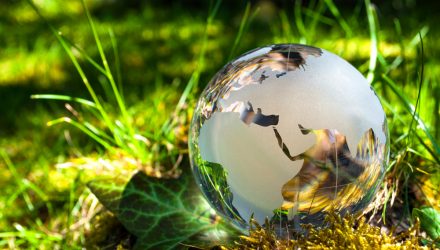Exchange traded fund investors should consider the investment opportunities in a greener future.
In the recent webcast, This Earth Day, Discover Portfolio Opportunities that Help Toward a Cleaner Future, Brandon Knott, Thematic and Specialty Strategist for ETFs and Indexed Strategies, Invesco, underscored the fact that global economies are targeting a greener future. It is only a matter of time before new clean sectors begin to take on a more prominent role. Specifically, 90% of the world’s GDP is on a course toward a net-zero carbon commitment.
The clean energy segment exhibited strong performance in 2020 as underlying fundamentals improved, demand for ESG exposure increased, and President Joe Biden outlined favorable climate proposals. However, the 2020 rally carried over into 2021 before losing steam in early February, which was most likely a post-election correction as valuations were overextended. Additionally, a broad tech and growth selloff also impacted the clean energy space.
More recently, Knott noted that market dynamics are improving in 2022 as the war in Ukraine drives home the need for energy independence and performance in growth, and small-caps found more relief.
There is a lot more room for the clean energy sector to run. Knott pointed out that renewable energy is still in its early innings, with plenty of room to grow into its future cap. The WilderHill Clean Energy Index is still only roughly 19% of the market cap of the oil and gas companies in the S&P Global Energy Index. While 57% of the WilderHill Clean Energy index is currently pre-earnings, 42% is in small-cap companies, reflecting the growth of emergent technologies.
Investors can look to something like the Invesco WilderHill Clean Energy ETF (PBW) for broad clean energy exposure. PBW, which follows the WilderHill Clean Energy Index. The ETF holds 80 stocks spread across the green energy equity landscape, ensuring that investors get a diverse portfolio in a fast-growing market segment.
Over the past year, we’ve seen growing commitments from major economies to reach for carbon neutrality. The goals are ambitious, with countries seeking to be carbon neutral by 2050 in many cases. Consequently, Knott argued that these ambitious goals will lead to significant investment near-term as countries reach 2030 progress points. For example, the US is likely to see renewables at 40% of energy by 2030, which requires a 10% CAGR for both solar and wind over the period.
Potable drinking water is also a growing global sustainability issue, with a 57% decrease in renewable water between 1962 and 2017. For instance, among the two most populous countries in the world, upwards of 70% of surface water in India and 70% of the water table in China have been deemed unfit for human consumption.
Knott noted that water scarcity is also complex, requiring technological solutions to address drivers that range from climate change to pollution and urbanization. The World Economic Forum projects that $26.4 trillion will need to be spent on water provisions by 2030 alone.
“Water and renewable energy could make for good complements,” Knott said. “While renewables have seen more rapid growth, water has shown more stable performance.”
Invesco offers three ETFs that invest in companies that process and distribute water: the Invesco Water Resources ETF (PHO), the Invesco S&P Global Water Index ETF (CGW), and the Invesco Global Water ETF (PIO).
PHO follows the NASDAQ OMX US Water Index, which seeks to track the performance of US exchange-listed companies that create products designed to conserve and purify water for homes, businesses, and industries.
CGW, which tracks the S&P Global Water Index, invests in water-related businesses, including water utilities, infrastructure, equipment, instruments, and materials.
PIO, which tracks the Nasdaq OMX Global Water Index, is positioned to benefit as the industrial and government cases for enhanced water management and technology expand. While PIO features exposure to seven global industry classification standard (GICS) sectors, industrial and utilities stocks usually loom large in water ETFs.
To help investors access the sustainable investment theme, Invesco recently came out with the Invesco MSCI Sustainable Future ETF (ERTH), which tracks the MSCI Environmental Select Index. The underlying index has six environmental themes: alternative energy, energy efficiency, green building, sustainable water, pollution prevention and control, and sustainable agriculture.
The Invesco Solar ETF (NYSEArca: TAN) provides broad exposure to the solar photovoltaic panel or solar energy sector. TAN is based on the MAC Global Solar Energy Index, which is comprised of companies in the solar energy industry.
Additionally, the Invesco Global Clean Energy ETF (PBD) exposes the global clean energy index, including U.S. and international stocks in the underlying portfolio. PBD also diversifies across various types of clean energy—such as wind, solar, and hydro—making it an exciting option for those looking to bet on a clean energy boom but unwilling to make a concentrated bet on a specific sub-sector.
“Invesco has long been a leader in the thematic space,” Knott said. “The majority of our suite has a ten-plus year track record, with our two flagship funds at fifteen years or more.”
Invesco also came out with a suite of environmental, social, and governance, or ESG, ETF offerings, including the Invesco ESG NASDAQ 100 ETF (QQMG), Invesco ESG NASDAQ Next Gen 100 ETF (QQJG), and Invesco ESG S&P 500 Equal Weight ETF (RSPE). Instead of focusing on a particular narrow theme such as solar power or green building, broad ESG offerings seek to create a version of a major index with more attractive ESG characteristics. Many broad ESG offerings are designed to significantly correlate with broad market indexes and frequently perform similarly to their non-ESG counterparts. This makes broad ESG offerings a reasonable choice for broad market exposure for many investors while also frequently enhancing the ESG characteristics of the entire portfolio, according to Knott.
Financial advisors who are interested in learning more about clean technology theme can watch the webcast here on demand.








